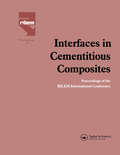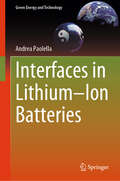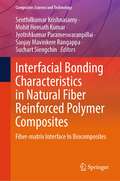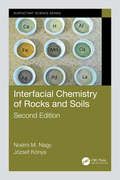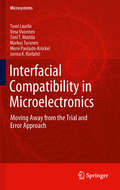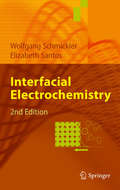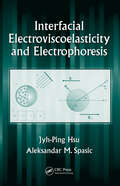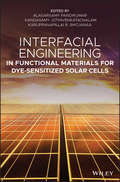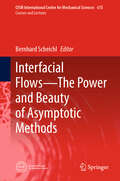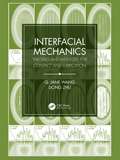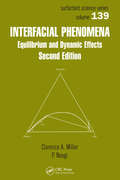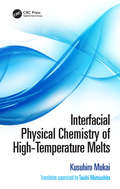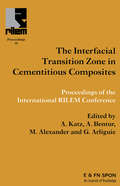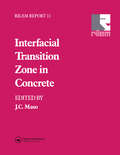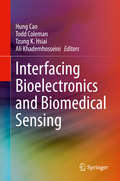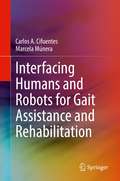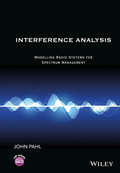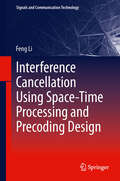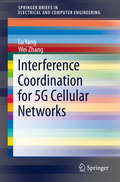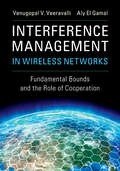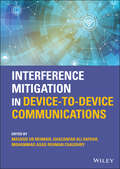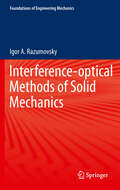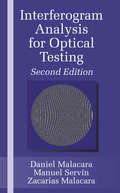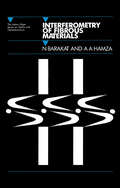- Table View
- List View
Interfaces in Cementitious Composites
by J.C. MasoThis book presents a series of high level contributions from leading research groups around the world in the field of cement and concrete science. It deals with the rapidly advancing subject of the interfaces between the components of cementitious materials: cements, aggregates, fibres, reinforcement. It will be valuable for all those involved with
Interfaces in Lithium–Ion Batteries (Green Energy and Technology)
by Andrea PaolellaThis book explores the critical role of interfaces in lithium-ion batteries, focusing on the challenges and solutions for enhancing battery performance and safety. It sheds light on the formation and impact of interfaces between electrolytes and electrodes, revealing how side reactions can diminish battery capacity. The book examines the nanochemistry of these reactions, emphasizing their profound influence on overall battery properties. It highlights the urgent need for battery material scientists to develop new additives and chemistries to address these interface-related issues, which have significant industrial implications. After providing a fundamental understanding of Li-ion batteries, the book analyzes the evolution of the solid electrolyte interface (SEI) by considering various negative electrode materials such as graphite, silicon, lithium metal, and anode-less configurations. It also explores the chemistries of cathode materials, including their decomposition and methods to mitigate unwanted oxidation. Furthermore, the book discusses the growing interest in solid-state batteries as a future technology, focusing on the reactivity of polymeric and ceramic solid electrolytes with anodes and cathodes, which presents additional challenges at the interface level. Finally, it addresses the specific challenges associated with emerging chemistries like Li-S and Li-air batteries, providing insights into polysulfide formation and LiOH conversion.
Interfacial Bonding Characteristics in Natural Fiber Reinforced Polymer Composites: Fiber-matrix Interface In Biocomposites (Composites Science and Technology)
by Jyotishkumar Parameswaranpillai Suchart Siengchin Sanjay Mavinkere Rangappa Senthilkumar Krishnasamy Mohit Hemath KumarThis book provides a general overview of the importance of fibre-matrix interfacial bonding characteristics in natural fibre-based composites to obtain optimal material properties for a specific application. Composites materials are prepared by combining fibres and polymers to achieve superior materials properties than those of the individual components. Composite materials are used to produce lightweight components with increased stiffness and strength; their properties can also be tailored for any specific applications. The glass fibre reinforced composites dominate 95% of the thermoplastic and thermoset-based composites. However, the natural fibre reinforced composites can give competition to the glass fibres due to their advantages such as biodegradability, low density, low cost, and good mechanical properties. This book looks into biocomposites and its important aspect of optimization of materials’ performance by fine-tuning the fibre-matrix bonding characteristics. The chapters in the book look at different plant fibres such as kenaf, pineapple leaf, jute, date palm, luffa, cotton, hemp, wood, bamboo, flax, and straw and the different approaches to enhance the fibre-matrix interfacial bonding through physical and/or chemical treatment methods. It demonstrates that the nature of fibre-matrix bonding has a significant effect on the properties such as tensile, flexural, impact, inter-laminar shear strength, moisture absorption, thickness swelling, thermal, chemical, damping, creep, and fatigue. Its content appeals to academics, students, researcher, and scientist who are working in the field to produce biodegradable and recyclable materials in the composite industry.
Interfacial Chemistry of Rocks and Soils (Surfactant Science #148)
by Noémi M. Nagy József KónyaKnowledge of the basic interactions that take place between geological materials and different substances is the first step in understanding the effects of adsorption and other interfacial processes on the quality of rocks and soils, and on driving these processes towards a beneficial or neutral result. Interfacial Chemistry of Rocks and Soils examines the different processes at solid and liquid interfaces of soil and rock, presenting a complete analysis that emphasizes the importance of chemical species on these interactions. This Second Edition features novel results in the field and expanded coverage of the kinetics of interfacial processes. New content includes models of heterogeneous isotope exchange, sorption isotherms for heterovalent cation exchange, as well as sorption of anions by chemically modified clays. Summarizing the results and knowledge of the authors’ research in this field over several decades, this volume: Explores the individual components of the studied systems: the solid, the solution, and the interface Discusses the characteristics and thermodynamics of the interface Profiles the most important analytical methods in the study of interfacial processes Demonstrates transformations initiated by interfacial processes Outlines avenues of treatment that may solve geological, soil science, and environmental problems Drawn chiefly from the authors’ years of research at the Imre Lajos Isotope Laboratory in the Department of Physical Chemistry at the University of Debrecen in Hungary, this book discusses chemical reactions on the surfaces/interfaces of soils and rocks; examines the role of these processes in environmental, colloid and geochemistry; and explores the effects on agricultural, environmental and industrial applications.
Interfacial Compatibility in Microelectronics
by Markus Turunen Toni T. Mattila Tomi Laurila Jorma Kivilahti Vesa Vuorinen Mervi Paulasto-KröckelInterfaces between dissimilar materials are met everywhere in microelectronics and microsystems. In order to ensure faultless operation of these highly sophisticated structures, it is mandatory to have fundamental understanding of materials and their interactions in the system. In this difficult task, the "traditional" method of trial and error is not feasible anymore; it takes too much time and repeated efforts. In Interfacial Compatibility in Microelectronics, an alternative approach is introduced. In this revised method four fundamental disciplines are combined: i) thermodynamics of materials ii) reaction kinetics iii) theory of microstructures and iv) stress and strain analysis. The advantages of the method are illustrated in Interfacial Compatibility in Microelectronics which includes: solutions to several common reliability issues in microsystem technology, methods to understand and predict failure mechanisms at interfaces between dissimilar materials and an approach to DFR based on deep understanding in materials science, rather than on the use of mechanistic tools, such as FMEA. Interfacial Compatibility in Microelectronics provides a clear and methodical resource for graduates and postgraduates alike.
Interfacial Electrochemistry
by Wolfgang Schmickler Elizabeth SantosElectrochemistry is an old branch of physical chemistry. Due to the development of surface sensitive techniques, and a technological interest in fuel cells and batteries, it has recently undergone a rapid development. This textbook treats the field from a modern, atomistic point of view while integrating the older, macroscopic concepts. The increasing role of theory is reflected in the presentation of the basic ideas in a way that should appeal to experimentalists and theorists alike. Special care is taken to make the subject comprehensible to scientists from neighboring disciplines, especially from surface science. The book is suitable for an advanced course at the master or Ph.D. level, but should also be useful for practicing electrochemists, as well as to any scientist who wants to understand modern electrochemistry.
Interfacial Electroviscoelasticity and Electrophoresis
by Jyh-Ping Hsu Aleksandar M. SpasicIn the 20 years since the pilot plant experiments used to develop the concept of electroviscoelasticity, inroads have been made in the understanding of its many related processes. Interfacial Electroviscoelasticity and Electrophoresis meets a massive scientific challenge by presenting deeper research and developments in the basic and applied scienc
Interfacial Engineering in Functional Materials for Dye-Sensitized Solar Cells
by Alagarsamy PandikumarOffers an Interdisciplinary approach to the engineering of functional materials for efficient solar cell technology Written by a collection of experts in the field of solar cell technology, this book focuses on the engineering of a variety of functional materials for improving photoanode efficiency of dye-sensitized solar cells (DSSC). The first two chapters describe operation principles of DSSC, charge transfer dynamics, as well as challenges and solutions for improving DSSCs. The remaining chapters focus on interfacial engineering of functional materials at the photoanode surface to create greater output efficiency. Interfacial Engineering in Functional Materials for Dye-Sensitized Solar Cells begins by introducing readers to the history, configuration, components, and working principles of DSSC It then goes on to cover both nanoarchitectures and light scattering materials as photoanode. Function of compact (blocking) layer in the photoanode and of TiCl4 post-treatment in the photoanode are examined at next. Next two chapters look at photoanode function of doped semiconductors and binary semiconductor metal oxides. Other chapters consider nanocomposites, namely, plasmonic nanocomposites, carbon nanotube based nanocomposites, graphene based nanocomposites, and graphite carbon nitride based nanocompositesas photoanodes. The book: Provides comprehensive coverage of the fundamentals through the applications of DSSC Encompasses topics on various functional materials for DSSC technology Focuses on the novel design and application of materials in DSSC, to develop more efficient renewable energy sources Is useful for material scientists, engineers, physicists, and chemists interested in functional materials for the design of efficient solar cells Interfacial Engineering in Functional Materials for Dye-Sensitized Solar Cells will be of great benefit to graduate students, researchers and engineers, who work in the multi-disciplinary areas of material science, engineering, physics, and chemistry.
Interfacial Flows—The Power and Beauty of Asymptotic Methods (CISM International Centre for Mechanical Sciences #615)
by Bernhard ScheichlThis book presents the state of the art of asymptotic and related mathematical methods, and how to apply them, as the means of choice, to representative building blocks of interfacial-flow phenomena. After an introduction which exemplifies the application of perturbation techniques in describing the well-known teapot effect, chapter 2 covers the status quo of the theory of inviscid sloshing and the associated modal analysis of free-surface waves; and chapter 3 envisages the intersection between dimensional analysis, scaling laws and the reduction of the governing partial differential equations to ordinary ones. The other chapters focus on, respectively, the singularity formation in free surfaces as a self-similar phenomenon in thin-film dynamics, the elastohydrodynamic lubrication by weakly viscoelastic fluids, and the inertia-free film flows under gravity with contact lines. It addresses graduate students and early-career researchers interested in theoretical fluid mechanics and its mathematical foundations, but also experienced scientists, actively employing perturbation analysis for long, who want to broaden their horizon.
Interfacial Mechanics: Theories and Methods for Contact and Lubrication
by Jane WangUnderstanding the characteristics of material contact and lubrication at tribological interfaces is of great importance to engineering researchers and machine designers. Traditionally, contact and lubrication are separately studied due to technical difficulties, although they often coexist in reality and they are actually on the same physical ground. Fast research advancements in recent years have enabled the development and application of unified models and numerical approaches to simulate contact and lubrication, merging their studies into the domain of Interfacial Mechanics. This book provides updated information based on recent research progresses in related areas, which includes new concepts, theories, methods, and results for contact and lubrication problems involving elastic or inelastic materials, homogeneous or inhomogeneous contacting bodies, using stochastic or deterministic models for dealing with rough surfaces. It also contains unified models and numerical methods for mixed lubrication studies, analyses of interfacial frictional and thermal behaviors, as well as theories for studying the effects of multiple fields on interfacial characteristics. The book intends to reflect the recent trends of research by focusing on numerical simulation and problem solving techniques for practical interfaces of engineered surfaces and materials. This book is written primarily for graduate and senior undergraduate students, engineers, and researchers in the fields of tribology, lubrication, surface engineering, materials science and engineering, and mechanical engineering.
Interfacial Phenomena in Adhesion and Adhesive Bonding
by Shin Horiuchi Nao Terasaki Takayuki MiyamaeThis open access book reviews the recent research achievements of the investigation of interfacial phenomena in polymer/polymer and polymer/metal joint interfaces with the state-of-the-art analytical techniques not previously used in the field of adhesion and bonding. Adhesion performance is determined not only by the two-dimensional interfaces but also by a three-dimensional (3D) region having different properties and structural characteristics that extends into the bulk materials. In this book, the authors also discuss in detail the bonding mechanism by characterizing such 3D regions called “interphase”. The book is of great interest to researchers and engineers devoted to adhesion science and technology. Videos via app: download the SN More Media app for free, scan an image or a link with play button, and access videos directly on your smartphone or tablet.
Interfacial Phenomena: Equilibrium and Dynamic Effects, Second Edition
by Clarence A. Miller P. NeogiSince the publication of the first edition of Interfacial Phenomena, the interest in interfaces and surfactants has multiplied, along with their applications. Experimental and theoretical advances have provided scientists with greater insight into the structure, properties, and behavior of surfactant and colloid systems.Emphasizing equil
Interfacial Physical Chemistry of High-Temperature Melts
by Taishi Matsushita Kusuhiro MukaiThis English translation of a well-known Japanese book covers interfacial physicochemistry in materials science, especially for iron- and steelmaking processes. Interfacial Physical Chemistry of High-Temperature Melts bridges the gap between the basics and applications of physicochemistry. The book begins with an overview of the fundamentals of interfacial physical chemistry and discusses surface tension, describing the derivation of important equations to guide readers to a deep understanding of the phenomenon. The book then goes on to introduce interfacial properties of high-temperature melts, especially the Marangoni effect, and discusses applications to materials processing at high temperature focusing on recent research results by the author and the co-workers. This book is aimed at researchers, graduate students, and professionals in materials processing. Video clips of in-situ observation including experiments under microgravity condition and x-ray observation are available for download on the publisher's website to allow for a deeper understanding.
Interfacial Transition Zone in Cementitious Composites
by M. Alexander A. Katz, A. Bentur G. ArliguieThis book addresses the need to resolve the ITZ's influence on engineering and durability characteristics of cementious composites, identifies the systems and properties that are affected by it, and quantifies these effects in order to prepare the base for engineering design tools. This volume presents the proceedings of the Second International RI
Interfacial Transition Zone in Concrete
by C. Maso JAn important state-of-the-art report prepared by RILEM Technical Committee 108 ICC. It has been written by a team of leading international experts from the UK, USA, Canada, Israel, Germany, Denmark, South Africa, Italy and France.
Interfacing Bioelectronics and Biomedical Sensing
by Todd Coleman Ali Khademhosseini Hung Cao Tzung K. HsiaiThis book addresses the fundamental challenges underlying bioelectronics and tissue interface for clinical investigation. Appropriate for biomedical engineers and researchers, the authors cover topics ranging from retinal implants to restore vision, implantable circuits for neural implants, and intravascular electrochemical impedance to detect unstable plaques. In addition to these chapters, the authors also document the approaches and issues of multi-scale physiological assessment and monitoring in both humans and animal models for health monitoring and biological investigations; novel biomaterials such as conductive and biodegradable polymers to be used in biomedical devices; and the optimization of wireless power transfer via inductive coupling for batteryless and wireless implantable medical devices. In addition to engineers and researchers, this book is also an ideal supplementary or reference book for a number of courses in biomedical engineering programs, such as bioinstrumentation, MEMS/BioMEMS, bioelectronics and sensors, and more.Analyzes and discusses the electrode-tissue interfaces for optimization of biomedical devices.Introduces novel biomaterials to be used in next-generation biomedical devices.Discusses high-frequency transducers for biomedical applications.
Interfacing Humans and Robots for Gait Assistance and Rehabilitation
by Carlos A. Cifuentes Marcela MúneraThe concepts represented in this textbook are explored for the first time in assistive and rehabilitation robotics, which is the combination of physical, cognitive, and social human-robot interaction to empower gait rehabilitation and assist human mobility. The aim is to consolidate the methodologies, modules, and technologies implemented in lower-limb exoskeletons, smart walkers, and social robots when human gait assistance and rehabilitation are the primary targets. This book presents the combination of emergent technologies in healthcare applications and robotics science, such as soft robotics, force control, novel sensing methods, brain-computer interfaces, serious games, automatic learning, and motion planning. From the clinical perspective, case studies are presented for testing and evaluating how those robots interact with humans, analyzing acceptance, perception, biomechanics factors, and physiological mechanisms of recovery during the robotic assistance or therapy. Interfacing Humans and Robots for Gait Assistance and Rehabilitation will enable undergraduate and graduate students of biomedical engineering, rehabilitation engineering, robotics, and health sciences to understand the clinical needs, technology, and science of human-robot interaction behind robotic devices for rehabilitation, and the evidence and implications related to the implementation of those devices in actual therapy and daily life applications.
Interference Analysis: Modelling Radio Systems for Spectrum Management
by John PahlThe book describes how interference can be managed so that radio systems co-exist, without harmful mutual effects, within a finite amount of spectrum. This is timely in view of the increasing proliferation of wireless systems. It covers both the processes, such as regional or international coordination, as well as the engineering principles. Written by an author with extensive experience in the industry, it describes in detail the main methodologies for calculating or computing the interference between radio systems of the same type, and also between radio systems of different types
Interference Cancellation Using Space-Time Processing and Precoding Design
by Feng LiInterference Cancellation Using Space-Time Processing and Precoding Design introduces original design methods to achieve interference cancellation, low-complexity decoding and full diversity for a series of multi-user systems. In multi-user environments, co-channel interference will diminish the performance of wireless communications systems. In this book, we investigate how to design robust space-time codes and pre-coders to suppress the co-channel interference when multiple antennas are available. This book offers a valuable reference work for graduate students, academic researchers and engineers who are interested in interference cancellation in wireless communications. Rigorous performance analysis and various simulation illustrations are included for each design method. Dr. Feng Li is a scientific researcher at Cornell University.
Interference Coordination for 5G Cellular Networks
by Wei Zhang Lu YangThis SpringerBrief presents interference coordination techniques for future 5G cellular networks. Starting with an overview of existing interference management techniques, it focuses on practical interference coordination schemes based on beamforming and user scheduling. The proposed schemes aim to deal with the inter-cell interference in multi-cell MIMO networks, cross-tier interference in device-to-device communications underlaying cellular network, and inter-network interference in cognitive radio networks. The performances of the proposed schemes are evaluated both analytically and numerically in terms of several performance parameters, including the sum rate, multiplexing gain, and outage probability of the networks. The results show that the proposed schemes can significantly reduce the effect of interference and improve the quality of service of the networks. Interference Coordination for 5G Cellular Networks is suitable for researchers and advanced students interested in interference coordination or 5G cellular networks.
Interference Management in Wireless Networks: Fundamental Bounds and the Role of Cooperation
by Venugopal V. Veeravalli Aly El GamalLearn about an information-theoretic approach to managing interference in future-generation wireless networks. Focusing on cooperative schemes motivated by coordinated multi-point (CoMP) technology, the book develops a robust theoretical framework for interference management that uses recent advancements in backhaul design, and practical pre-coding schemes based on local cooperation, to deliver the increased speed and reliability promised by interference alignment. Gain insight into how simple, zero-forcing pre-coding schemes are optimal in locally connected interference networks, and discover how significant rate gains can be obtained by making cell association decisions and allocating backhaul resources based on centralized (cloud) processing and knowledge of network topology. Providing a link between information-theoretic analyses and interference management schemes that are easy to implement, this is an invaluable resource for researchers, graduate students, and practicing engineers in wireless communications.
Interference Mitigation in Device-to-Device Communications
by Masood Ur Rehman Ghazanfar Ali Safdar Mohammad Asad Rehman ChaudhryExplore this insightful foundational resource for academics and industry professionals dealing with the move toward intelligent devices and networks Interference Mitigation in Device-to-Device Communications delivers a thorough discussion of device-to-device (D2D) and machine-to-machine (M2M) communications as solutions to the proliferation of ever more data hungry devices being attached to wireless networks. The book explores the use of D2D and M2M technologies as a key enabling component of 5G networks. It brings together a multidisciplinary team of contributors in fields like wireless communications, signal processing, and antenna design. The distinguished editors have compiled a collection of resources that practically and accessibly address issues in the development, integration, and enhancement of D2D systems to create an interference-free network. This book explores the complications posed by the restriction of device form-factors and the co-location of several electronic components in a small space, as well as the proximity of legacy systems operating in similar frequency bands. Readers will also benefit from the inclusion of: A thorough introduction to device-to-device communication, including its history and development over the last decade, network architecture, standardization issues, and regulatory and licensing hurdles An exploration of interference mitigation in device-to-device communication underlaying LTE-A networks A rethinking of device-to-device interference mitigation, including discussions of the challenges posed by the proliferation of devices An analysis of user pairing for energy efficient device-to-device content disseminationPerfect for researchers, academics, and industry professionals working on 5G networks, Interference Mitigation in Device-to-Device Communications will also earn a place in the libraries of undergraduate, graduate, and PhD students conducting research into wireless communications and applications, as well as policy makers and communications industry regulators.
Interference-optical Methods of Solid Mechanics
by Igor A. Razumovsky Galkin Anatoliy YakovlevichThis reference tutorial contains modern experimental approaches to analysis of strain-stress distribution based on interference-optical methods of registration of strain or displacement fields, including coherent-optical techniques (holographic interferometry, speckle photography, electronic digital speckle interferometry techniques) and photoelastic methods as well as the shadow optical method of caustic. The book describes the theory, efficient scope of application in the every-day practice and the problems of further development of these techniques. Much attention is paid to new and promising advanced developments in the field of observation and computational methods for study of residual stress, determination of fracture mechanics parameters and material deformation characteristics. The content corresponds to the course of lectures delivered by the author at the N.E. Bauman Moscow State Technical University. It is intended for technical university students, research engineers and postgraduate students who are doing analysis of strain-stress state and strength of structural elements.
Interferogram Analysis For Optical Testing
by Zacarias Malacara Manuel ServínIn this day of digitalization, you can work within the technology of optics without having to fully understand the science behind it. However, for those who wish to master the science, rather than merely be its servant, it's essential to learn the nuances, such as those involved with studying fringe patterns produced by optical testing interferometers.When Interferogram Analysis for Optical Testing originally came to print, it filled the need for an authoritative reference on this aspect of fringe analysis. That it was also exceptionally current and highly accessible made its arrival even more relevant. Of course, any book on something as cutting edge as interferogram analysis, no matter how insightful, isn't going to stay relevant forever. The second edition of Interferogram Analysis for Optical Testing is designed to meet the needs of all those involved or wanting to become involved in this area of advanced optical engineering. For those new to the science, it provides the necessary fundamentals, including basic computational methods for studying fringe patterns. For those with deeper experience, it fills in the gaps and adds the information necessary to complete and update one's education. Written by the most experienced researchers in optical testing, this text discusses classical and innovative fringe analysis, principles of Fourier theory, digital image filtering, phase detection algorithms, and aspheric wavelength testing. It also explains how to assess wavefront deformation by calculating slope and local average curvature.
Interferometry of Fibrous Materials
by N Barakat A A HamzaInterferometry of Fibrous Materials shows how interferometric methods can be used in optical, synthetic, and natural fiber analysis. This practical volume features a large number of both color and black and white interferograms to enhance understanding of how interferometry is used to determine a fibre's optical properties.
